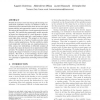Free Online Productivity Tools
i2Speak
i2Symbol
i2OCR
iTex2Img
iWeb2Print
iWeb2Shot
i2Type
iPdf2Split
iPdf2Merge
i2Bopomofo
i2Arabic
i2Style
i2Image
i2PDF
iLatex2Rtf
Sci2ools
CONEXT
2007
ACM
2007
ACM
The diameter of opportunistic mobile networks
Portable devices have more data storage and increasing communication capabilities everyday. In addition to classic infrastructure based communication, these devices can exploit human mobility and opportunistic contacts to communicate. We analyze the characteristics of such opportunistic forwarding paths. We establish that opportunistic mobile networks in general are characterized by a small diameter, a destination device is reachable using only a small number of relays under tight delay constraint. This property is first demonstrated analytically on a family of mobile networks which follow a random graph process. We then establish a similar result empirically with four data sets capturing human mobility, using a new methodology to efficiently compute all the paths that impact the diameter of an opportunistic mobile networks. We complete our analysis of network diameter by studying the impact of intensity of contact rate and contact duration. This work is, to our knowledge, the first v...
| Added | 14 Aug 2010 |
| Updated | 14 Aug 2010 |
| Type | Conference |
| Year | 2007 |
| Where | CONEXT |
| Authors | Augustin Chaintreau, Abderrahmen Mtibaa, Laurent Massoulié, Christophe Diot |
Comments (0)

